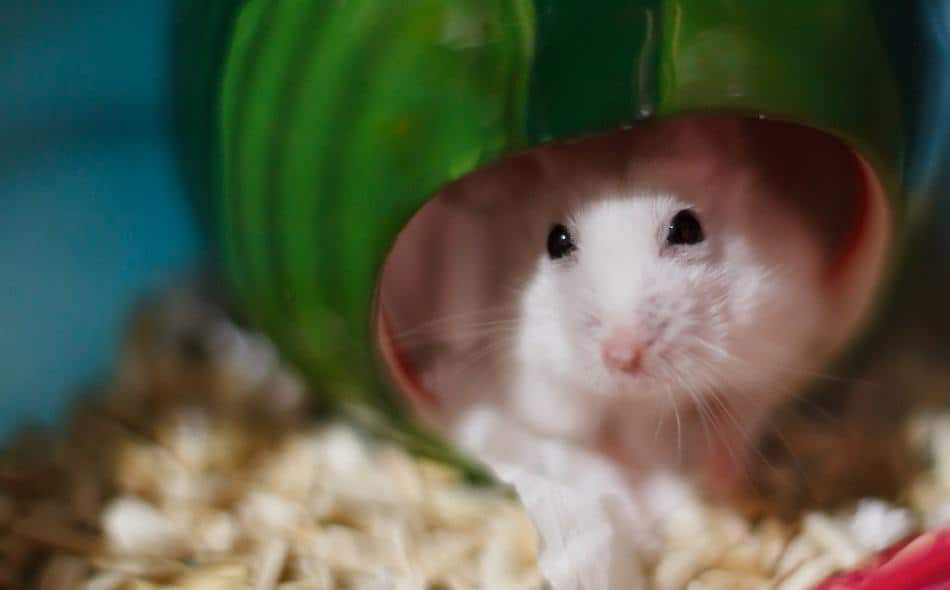
Hamsters can show a lot of different behaviors throughout the day and those behaviors can have multiple meanings.
So behavior that usually means that they’re sad can also sometimes mean something else as well, like anxiety.
That can be a little confusing sometimes, so for my fellow hamster owners, I did some research into the different ways that you can tell if a hamster is sad.
That way it’ll be easier to tell if your hamster is actually sad or if the behavior that they’re showing means something else.
Table of Contents
A Sad Hamster Can Act Lethargic
One of the first ways that you can tell if your hamster is sad is if they’re acting more lethargic rather than energetic or playful.
You can tell that they’re acting lethargic if they seem to be sleeping more than they usually do and they’re not coming out of their home as much either. Sometimes that can be accompanied by appetite loss as well.
So if your hamster is sad then you might see them not eating and drinking as much as they normally do and you might not see them as often because they’re hiding in their little huts.
That being said though, sometimes when a hamster acts lethargic it’s not always out of sadness and can sometimes be considered signs of a health problem.
So if they’re acting lethargic and you think that they may have some type of health issue then it’s best if you take them to see your local vet.
Sad Hamsters Can Show Repetitive Behaviors
Another way to tell that your hamster might be sad is if you notice that they’re doing a lot of repetitive behaviors.
One example of this is if you see your hamster pacing back and forth throughout their cage.
Sometimes they’ll be pacing in random places and other times they’ll be doing it along the sides of their cage.
When they start to pace back and forth closer to the walls of their cage that can mean that they’re sad, however, it can also mean that they’re anxious about something as well.
Another example of repetitive behavior in a sad hamster is if you notice that they’re moving their bedding around to the same locations over and over again.
That can be something like taking their bedding out of their hut and putting some of that same bedding back in it repeatedly.
Sometimes they’ll also do the same thing by taking their toys in and out of their hut as well.
When A Hamster Is Sad They Can Be Overly Aggressive
Hamsters that are starting to become sad might also start to get overly aggressive throughout the day.
So if you have a hamster that’s normally cool and calm and they start to become more aggressive than usual then that can be a sign that they’re starting to become sad.
One way that they can show this aggressiveness is if they nip at you when they normally wouldn’t do something like that.
So if your hamster starts to get aggressive with you but you know that they’re used to you or used to your hand being near them, then something may be wrong.
They might also start to aggressively move items around in their cage when they’re sad, so that’s something to look out for as well.
A Sad Hamster May Start Biting Their Cage
A sad or anxious hamster can start to aggressively bite their cage more often than they normally do.
When they start to do that it can look like they’re trying to escape and that can look really alarming sometimes.
But biting their cage usually means that they’re sad or anxious because they’re in a cage that’s too small for them.
Hamsters need enough space to be able to roam around and play and if they don’t have that space then it can make them start to feel boxed-in which can lead to them becoming sad.
That being said though, hamsters will chew on almost anything that they can get their hands on.
So sometimes that can just be from boredom or not having enough chew toys to chew on.
Sad Hamsters May Climb Their Cage More Often
As I said before, hamsters have a lot of different behaviors that can have multiple meanings, and one of those behaviors is climbing their cage.
A hamster can climb their cage when they’re feeling sad sometimes, but it can also mean that they’re trying to escape or that they’re just plain bored.
So to tell if your hamster is climbing because they’re sad about something you need to know if that’s an activity that they usually do.
For example, if your hamster has been climbing their cage since you first got them and they’re acting normally throughout the rest of the day then they’re probably just fine.
Some hamsters just climb their cage because that’s something that they like to do and that’s totally normal for them.
However, if they just started climbing their cage and you know for a fact that they haven’t displayed this type of behavior before, then that can be a sign that your hamster is sad.
Overly Grooming Can Be A Sign Of A Sad Hamster
Hamsters can groom themselves for many reasons but they mainly do it to clean themselves, which is completely normal to see them doing.
But when their grooming starts to become more and more excessive, that’s when you know that something might be wrong.
Overly grooming themselves can be a sign that they are sad or anxious about something.
So you’ll see them constantly groom their body even after they’re already clean more than a few times throughout the day.
However, overly grooming themselves can also indicate that they’re having some type of skin issues as well.
So if you notice that their skin starts to look too dry or their fur is becoming patchy after all that grooming then they might be having some health issues.
If that’s the case then it could be time to take your hamster to see your local vet or if you don’t have the time to drive to the vet’s office then you can consult an online vet.
A Hamster That’s Sad May Start Laying Down In Random Places
If your hamster is sad then you may start to see them laying down in places that can seem random.
Laying down and relaxing is normal for hamsters to do most of the time, but when you start to notice more and more of that behavior then that can be a sign that they’re feeling sad or depressed.
Hamsters will normally lay down in their little huts and sometimes they’ll go to the corner of their cage to do it.
But when they start to lay down in the open parts of their cage rather than in their normal locations, then that can mean that they might be sad.
Hamsters are prey animals, so laying down for an extended amount of time out in the open parts of their cage is not that normal for them to do.
They’re more likely to lay down in places like their homes where they can feel safe and comfortable.
So when you start to see them lay down in places that aren’t normal, then that’s a way that you can tell that something is wrong and your hamster might be sad.
